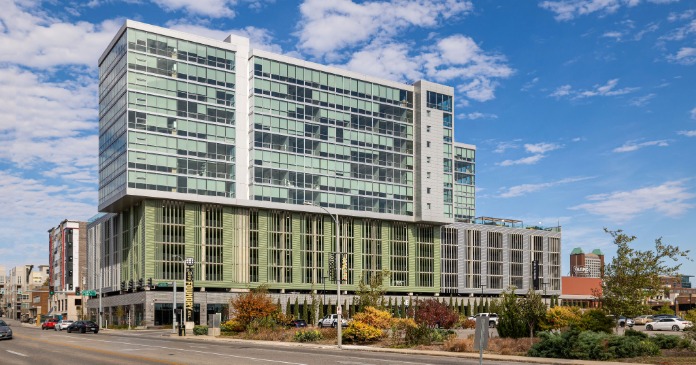Where and how we work has changed a lot in the past several years.
Collectively, we’ve experienced some of the most significant and far-reaching changes in the world of work since the Industrial Revolution. Zoom became a noun and a cultural phenomenon (“You’re on mute!”) as workers experimented (and largely succeeded) with working from home during the pandemic.
Next came the “return to office” tug of war, as employers sought to get teams back together in offices and employees held fast to the benefits of flexible working schedules. The outcome? A meeting in the middle: hybrid work schedules in which hundreds of millions of workers split time between home and offices.
With the rhetoric around “return-to-office” finally behind us, it’s clear that 2024 will be another watershed year in which how we engage with work environments is redefined again. As CEO of a leading proptech company, I connect with C-level executives and workplace experts daily, discussing the forces that will continue to reshape the world of work in 2024. Here is my take on seven key trends that will alter workplaces and work environments in 2024.
Data-driven workplace strategies
For the past two years, senior leaders across many industries have demanded a full return to office and pre-Covid work behaviors. It hasn’t worked. Despite get-tough initiatives and threats, average workplace utilization has remained unchanged since Q2 of 2023.
While most workers now spend some time in offices, hybrid work schedules are here to stay, leaving average workplace utilization at about 50 percent of pre-pandemic levels.
Eighty percent of executive leaders now say they took the wrong approach to the return to office because they based decisions on hunches rather than data. To find a better way, they will ask their real estate and workplace teams to chart the future of their workspaces with approaches rooted in data.
Workplace attendance incentivized
Angry emails and threats failed to force workers to return to a five-day in-office schedule. The era of office-attendance coercion is giving way to a more nuanced approach to incentivizing in-person engagement.
Companies are reimagining workplace culture by offering enticing perks such as happy hours, catered meals and revamped office environments to foster a sense of belonging when teams are together in offices. Yes, employees can work from home, but individual well-being and career prospects will be improved by spending at least some time in an office.
Organizations use better data tools
Traditional methods of tracking workplace attendance, like badge swipes, provide limited data to help companies understand the resources and space teams need. “Coffee-badging” and other outmaneuvering tactics make even limited badge data suspect.
Now, many companies are exploring better technologies and solutions to understand exactly what workers are doing in offices, and when. By harnessing real-time data on office utilization and resource allocation, organizations can optimize operational efficiency and create tailored work environments conducive to productive collaboration.
Workplace utilization increases
While hard-core work-from-homers want 100 percent remote roles, a recent Gensler research study showed that workers in many countries believe more time in the office will improve their socializing/companionship, collaboration, relationship-building, training and career advancement. Challenges like commuting costs and childcare are holding many back. As companies offer more incentives, we can expect a gradual increase in workplace attendance throughout the year.
Many workplaces will shrink
With workers spending only two or three days in the office and devoting much of that time to meetings, antiquated concepts like dedicated desks for every employee no longer fit.
Real estate services leader CBRE reports that the average space per employee shrank by 22 percent in 2023, and 62 percent of companies have reduced their office space since 2020. Workplace shrinking will continue in 2024 as more company leases come up for renewal, and companies recognize that the hybrid model is here to stay.
Transition to shared spaces
Traditional desk ratios are giving way to flexible seating models like hot-desking, signaling a fundamental shift toward shared workspaces. By reallocating resources and prioritizing collaborative environments over individual workstations, organizations are optimizing space utilization and nurturing a culture of inclusivity and teamwork.
The demand for flexible workspaces is skyrocketing. Companies are embracing on-demand access to shared workspaces and resources, driving the need for adaptable workplace designs that cater to diverse work preferences and evolving organizational needs.
Workplace experience elevated
While many companies will end 2024 with smaller offices, many are prioritizing premium office locations equipped with state-of-the-art designs and technology. These upgrades are intended to improve productivity and provide more positive reinforcement for the decision to come into the office.
By investing in modern amenities and fostering vibrant work cultures, organizations create enticing work environments that attract top talent and enhance employee satisfaction and productivity.
Change is scary to some. For workplace leaders, though, this change provides an opportunity to create environments that make work more engaging and rewarding as they drive outstanding ROI for companies.
As companies move away from negative tactics like return-to-office mandates, workplace leaders can get back to doing what they love: connecting people with place and purpose.
Let 2024 be the year companies embrace the opportunity to reimagine their office spaces to reflect the needs of their teams in a post-pandemic world.
Author Alex Birch is cofounder and CEO of XY Sense, which provides sensors that enable property teams to understand workplace usage.











